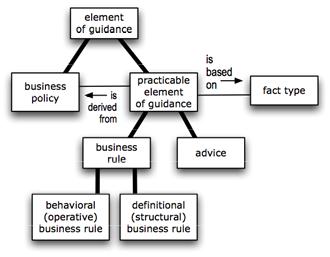For business analysts, understanding decision logic from the perspective of business people is key. For that you need business rules. But when can a rule be considered a business rule, and when not? This article presents five pragmatic tests for knowing when you have identified a true business rule.
Introduction
 Consider the rule:A log-in must be cancelled if the user enters the wrong password more than 5 times. Business rule?
Consider the rule:A log-in must be cancelled if the user enters the wrong password more than 5 times. Business rule?
The tests for distinguishing business rules from system or IT rules are straightforward. There are five basic tests. All five tests must be true before a rule is a true business rule. The first three tests are the following.
Test 1.The rule must be practicable. This test entails the question, ‘Would a worker who is duly authorized and capable know what to do or not to do when she reads it?’ Consider the statement:No shirt, no service.Probably passes the practicable test. Consider this statement:Come as you are.Probably not practicable. A worker can't read it and know exactly what to do or not to do. The statement must be interpreted into something that is truly practicable (e.g.,No swimming suits.). More aboutpracticable later.
Test 2.The rule must be about the business, not about either (a) a system that supports the business, or (b) a platform used to implement such a system. A rule of thumb is this: If you threw away the system – any system, even pencil and paper – would the rule still be important in running the business? Business people should be managing business things, not system things.
Test 3.The rule must be expressed in the language of the business, not in the language of either (a) a system or (b) a platform. To be a business rule, a business person must be able to understand a statement or representation without significant training or experience in IT or IT-built systems.
Now back to the rule: A log-in must be cancelled if the user enters the wrong password more than 5 times.This rule satisfies tests 1 and 3, but not 2. Not a businessrule according to the tests.
How about this example: No credit card, no order. This rule does satisfy all three tests. So yes, a business rule.
Does this clear distinction between business rules and system or platform rules ever break down? One commonly cited example where the line blurs is with security rules. However, such rules often pertain directly to a system or the data in it. Consider this example: A person logged on to the system as a junior adjudicator may request customer data from the customer database only from the local server.This rule satisfies test 1 above – it’s practicable – but not 2 and maybe not 3. So not a business rule. Does that mean the rule is any less important to the business? No. It’s a rule, but simply not a businessrule.
Consider another example: A junior adjudicator may be informed only about customers in his local district. Throw out the systems, you still need the rule. So yes, a business rule.
Two additional tests for when a rule can be considered a business rule are the following:
Test 4. The rule must be under business jurisdiction. “Under business jurisdiction” is taken to mean that the business can enact, revise, and discontinue the business rule as it sees fit. If a rule is not under business jurisdiction in that sense, then it is not a business rule. For example, the ‘law’ of gravity is obviously not a business rule. Neither are the ‘rules’ of mathematics.
Test 5. The rule must tend to remove a degree of freedom. If some guidance is given but does not tend to remove some degree of freedom, it still might be useful, but it is not a rule per se. Such guidance is called an advice(or sometimes a non-rule).
Consider the statement:A bank account may be held by a person of any age.Although the statement certainly gives business guidance, it does not directly:
Because the statement removes no degree of freedom, it does not express a business rule.Rather, it expresses something that is a non-rule — a.k.a. an advice.
Is it important then to write the advice down (i.e., capture and manage it)? Maybe. Suppose the statement reflects the final resolution of a long-standing debate in the company about how old a person must be to hold a bank account. Some say 21, others 18, some 12, and some say there should be no age restriction at all. Finally the issue is resolved in favor of no age restriction. It’s definitely worth writing that down!
Now consider this statement: An order $1,000 or less may be accepted on credit without a credit check. This statement of advice is different. It suggests a business rule that possibly hasn’t been captured yet: An order over $1,000 must not be accepted on credit without a credit check.. Let’s assume the business needs this rule and considers it valid.
In that case you should write the business rule down — not the advice — because only the business rule actually removes any degree of freedom. Just because the advice says an order $1,000 or less may be accepted on credit without a credit check, that does not necessarily mean an order over $1,000 must not. A statement of advice only says just what it says.
Categorization of Business Rules
Figure 1 presents an overall categorization of guidance from the perspective of business people.2 All rules are either behavioral(also called operative) or definitional (also called structural). I will discuss the distinction between these two categories of business rule in my next column.
Figure 1. Categorization of business guidance.

More About Business Rules Being Practicable
In contrast to a business policy, a business rule needs to be practicable.This means that a person who knows about a business rule could observe a relevant situation including his or her own behavior and decide directly whether or not the business was complying with the business rule. In general, a business policy is not practicable in that sense; a business policy must be interpreted into some more concrete business rule(s) that satisfy its supposed intent. (That’s what the fact type in Figure 1 worded practicable element of guidance is derived from business policy is about.) For example the following business policy is not practicable:: Safety is our first concern.
Just because business rules are practicable does notimply they are always automatable — many arenot.For instance, consider the business rule: A hard hat must be worn in a construction site.. Non-automatable rules need to be implemented within user activity. In many ways, managing non-automatable rules is even more difficult than managing automatable ones. They definitely have a place in your rulebook.
For a business rule (or an advice) to be practicable assumes that the business vocabulary on which it is based has been adequately developed, and has been made available as appropriate. Note the fact type in Figure 1 worded practicable element of guidance is based on fact type.. Every business rule (and advice) should be directly based on a structured business vocabulary.

Author: Ronald G. Ross - Featured Speaker, www.AttainingEdge.com.
For more about the author, see www.RonRoss.info.
[1] Portions of this article were excerpted from Chapter 7, Business Rule Concepts:Getting to the Point of Knowledge (3rd Ed.), by Ronald G. Ross, August 2009. ISBN 0-941049-07-8 www.brsolutions.com/publications.php
[2] This discussion of business rules is based on, and consistent with, the OMG 2007 standard Semantics of Business Vocabulary and Business Rules(SBVR). For more about SBVR, see my article, “The Emergence of SBVR and the True Meaning of “Semantics”: Why You Should Care (a Lot!),” Business Rules Journal, Vol. 9, No. 3 (Mar. 2008), URL:www.BRCommunity.com/a2008/b401.html.